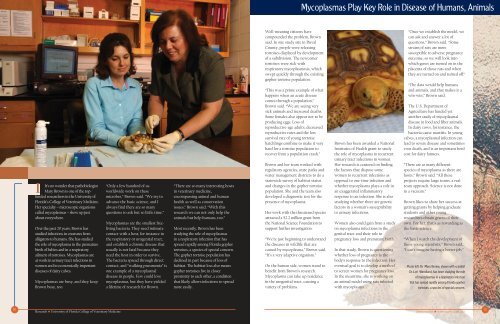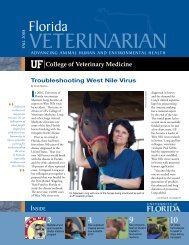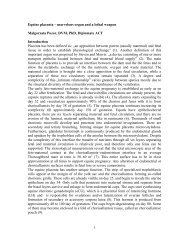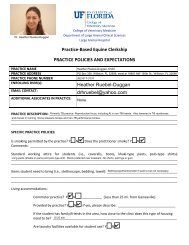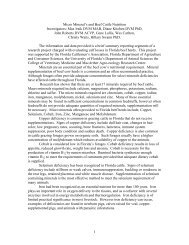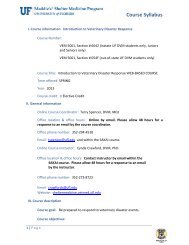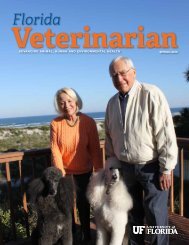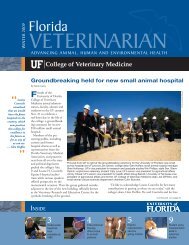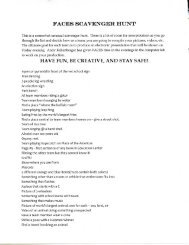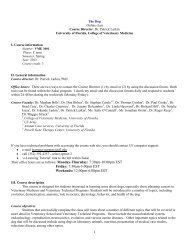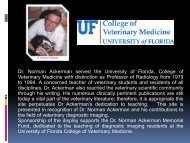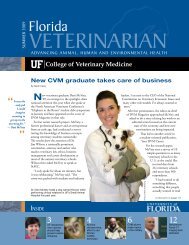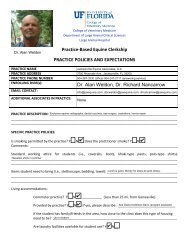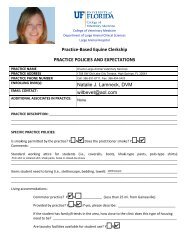College of Veterinary Medicine Research Brochure
College of Veterinary Medicine Research Brochure
College of Veterinary Medicine Research Brochure
- No tags were found...
Create successful ePaper yourself
Turn your PDF publications into a flip-book with our unique Google optimized e-Paper software.
Mycoplasmas Play Key Role in Disease <strong>of</strong> Humans, AnimalsIIt’s no wonder that pathobiologistMary Brown is one <strong>of</strong> the topfundedresearchers in the University <strong>of</strong>Florida’s <strong>College</strong> <strong>of</strong> <strong>Veterinary</strong> <strong>Medicine</strong>.Her specialty – microscopic organismscalled mycoplasmas – show up justabout everywhere.Over the past 20 years, Brown hasstudied infections in creatures fromalligators to humans. She has studiedthe role <strong>of</strong> mycoplasma in the prematurebirth <strong>of</strong> babies and in a respiratoryailment <strong>of</strong> tortoises. Mycoplasmas areat work in urinary tract infections inwomen and in economically importantdiseases <strong>of</strong> dairy calves.Mycoplasmas are busy, and they keepBrown busy, too.“Only a few hundred <strong>of</strong> usworldwide work on thesemicrobes,” Brown said. “We try toadvance the basic science, and Ialways find there are so manyquestions to ask but so little time.”Mycoplasmas are the smallest freelivingbacteria. They need intimatecontact with a host, for instance inthe respiratory or urogenital tract,and establish a chronic disease thatusually is not fatal because theyneed the host in order to survive.The bacteria spread through directcontact, and “walking pneumonia” isone example <strong>of</strong> a mycoplasmaldisease in people. Few could lovemycoplasmas, but they have yieldeda lifetime <strong>of</strong> research for Brown.“There are so many interesting hostsin veterinary medicine,encompassing animal and humanhealth as well as conservationissues,” Brown said. “With thisresearch we can not only help theanimals but help humans, too.”Most recently, Brown has beenstudying the role <strong>of</strong> mycoplasmasin a respiratory infection that hasspread rapidly among Florida gophertortoises, a species <strong>of</strong> special concern.The gopher tortoise population hasdeclined in part because <strong>of</strong> loss <strong>of</strong>habitat. The habitat loss also meansgopher tortoises live in closerproximity to each other, a conditionthat likely allows infections to spreadmore easily.Well-meaning citizens havecompounded the problem, Brownsaid. In one study site in DuvalCounty, people were releasingtortoises displaced by development<strong>of</strong> a subdivision. The newcomertortoises were sick withrespiratory mycoplasmosis, whichswept quickly through the existinggopher tortoise population.“This was a prime example <strong>of</strong> whathappens when an acute diseasecomes through a population,”Brown said. “We are seeing verysick animals and increased deaths.Some females also appear not to beproducing eggs. Loss <strong>of</strong>reproductive-age adults, decreasedreproductive rates and the lowsurvival rate <strong>of</strong> young tortoisehatchlings combine to make it veryhard for a tortoise population torecover from a population crash.”Brown and her team worked withregulatory agencies, state parks andwater management districts to do astatewide survey <strong>of</strong> habitat statusand changes in the gopher tortoisepopulation. She and the team alsodeveloped a diagnostic test for thepresence <strong>of</strong> mycoplasma.Her work with the threatened speciesattracted a $2.2 million grant fromthe National Science Foundation tosupport further investigation.“We’re just beginning to understandthe diseases in wildlife that arecaused by mycoplasma,” Brown said.“It’s a very adaptive organism.”On the human side, women stand tobenefit from Brown’s research.Mycoplasma can take up residencein the urogenital tract, causing avariety <strong>of</strong> problems.Brown has been awarded a NationalInstitutes <strong>of</strong> Health grant to studythe role <strong>of</strong> mycoplasma in recurrenturinary tract infections in women.Her research is centered on findingthe factors that dispose somewomen to recurrent infections asopposed to one-time infection andwhether mycoplasma plays a role inan exaggerated inflammatoryresponse to an infection. She is alsostudying whether there are geneticfactors in a woman’s susceptibilityto urinary infections.Women also could gain from a studyon mycoplasma infections in thegenital tract and their role inpregnancy loss and premature birth.In that study, Brown is questioningwhether loss <strong>of</strong> pregnancy is thebody’s response to the infection. Hereventual goal is to develop a methodto screen women for pregnancy loss.In the meantime, she is working onan animal model using rats infectedwith mycoplasma.“Once we establish the model, wecan ask and answer a lot <strong>of</strong>questions,” Brown said. “Somestrains <strong>of</strong> rats are moresusceptible to adverse pregnancyoutcome, so we will look intowhich genes are turned on in theplacenta <strong>of</strong> those rats and whenthey are turned on and turned <strong>of</strong>f.”“The data would help humansand animals, and that makes it awin-win,” Brown said.The U.S. Department <strong>of</strong>Agriculture has funded yetanother study <strong>of</strong> mycoplasmaldisease in food and fiber animals.In dairy cows, for instance, thebacteria cause mastitis. In youngcalves, a mycoplasmal infection canlead to severe disease and sometimeseven death, and is an important herdcost for dairy farmers.“There are as many differentspecies <strong>of</strong> mycoplasma as there arehosts,” Brown said. “All theseprojects require large teams, a realteam approach. Science is not donein a vacuum.”Brown likes to share her success atgetting grants by helping graduatestudents and other youngresearchers obtain grants <strong>of</strong> theirown. For her, that’s as rewarding asthe basic science.“When I watch the development <strong>of</strong>these young scientists,” Brown said,“I can’t imagine having a better job.”Photo left: Dr. Mary Brown, shown with scientistDr. Lori Wendland, has been studying the role<strong>of</strong> mycoplasmas in a respiratory infectionthat has spread rapidly among Florida gophertortoises, a species <strong>of</strong> special concern.30<strong>Research</strong> • University <strong>of</strong> Florida <strong>College</strong> <strong>of</strong> <strong>Veterinary</strong> <strong>Medicine</strong>••Environment • www.vetmed.ufl.edu31


